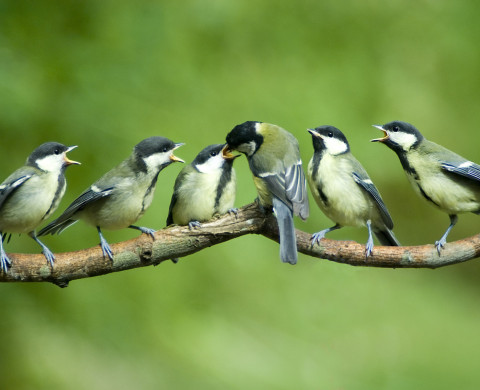Seasonal timing of growth and reproduction: ultimate functions and proximate mechanisms

For many species, there is only a short period in the annual cycle in which conditions are suitable for reproduction or growth. This period is often determined by other species, at a lower trophic level: the timing of herbivore growth is constrained by the phenology of the vegetation, predator reproduction by herbivore abundance, etc. Spring temperatures have increased over the past 40 years, and this has affected the phenology of many species. An important question is whether all levels in multi-trophic interactions are affected at the same rate, i.e. whether synchronization of phenology is maintained under large-scale climate change.
The Visser group is concentrating on three model systems. Winter moth (Operophtera brumata) eggs need to hatch at the time of oak (Quercus robur) bud burst so that the small caterpillars can feed on the fresh leaves. Both oak bud burst and winter moth egg hatching advance with warmer spring temperatures, but the winter moth does so much stronger, leading to severe mistiming (PhD project of Natalie van Dis). Mistiming also occurs in the great tits (Parus major), which do not advance their laying date as much as the phenology of the abundance of prey for their nestlings, which now peaks nine days earlier (PhD project of Melanie Lindner). Finally, the timing of the different parts of the life cycle of the pied flycatcher (Ficedula hypoleuca) - timing of breeding, moult, migration, etc - are affected differently by climate change, which may lead to mismatches between life cycle events.
In all three of these model systems we aim to understand why mistiming occurs, whether natural selection will lead to a better phenological synchronisation, and what the population consequences are of the mistiming. We collect field data and analyse long-term data sets (for the great tit on a European wide scale – in the SPI Birds project), carry out field experiments in our long-term population studies (for the great tit to manipulate laying date) and carry out controlled environment experiments in the laboratory (for the great tit in climate controlled aviaries, for the pied flycatcher to estimate heritability of the onset of migration, for the winter moth to estimate heritability of the timing mechanism). Using these data, we study the ecology, the evolution and the underlying physiology of timing.
More recently, we have started to work on genomic variation - using the sequenced great tit and winter moth genomes. We have genotyped over 2000 wild great tits using our 650 kSNP chip. We have used these data to create genomically selected selection lines for early and late lines (ERC Advanced project – Visser). Furthermore, we have DNA methylation and RNA data from these selection lines (PhD project Melanie Lindner). In winter moths we are sequencing historical samples (up to 20 years) and have RNA data from experimental set-up to study which genes are involved in the temperature dependent development rates (PhD project Natalie van Dis). We use these studies to unravel the molecular genetic architecture underlying seasonal timing to get more insight in the links between genotypes and phenotypes, and how there are shaped by environmental conditions.
Experts
-

-
Melanie Lindner
Guest researcher , Animal Ecology -
Natalie E. van Dis
Guest researcher , Animal Ecology
